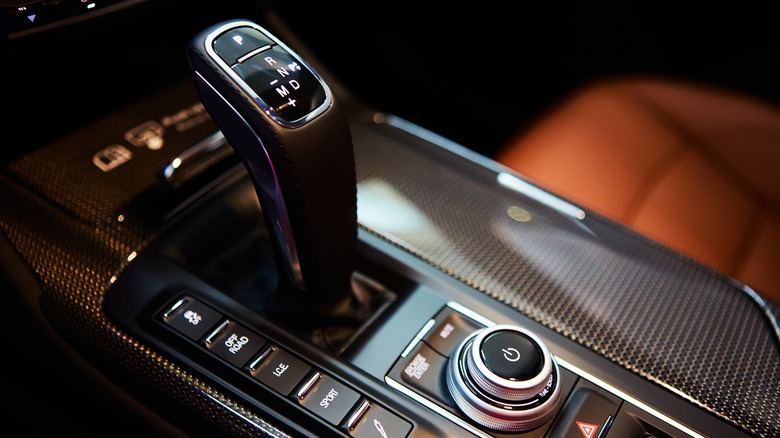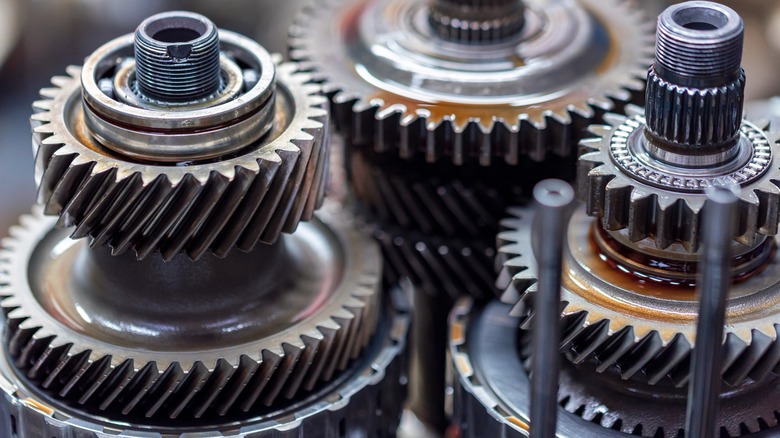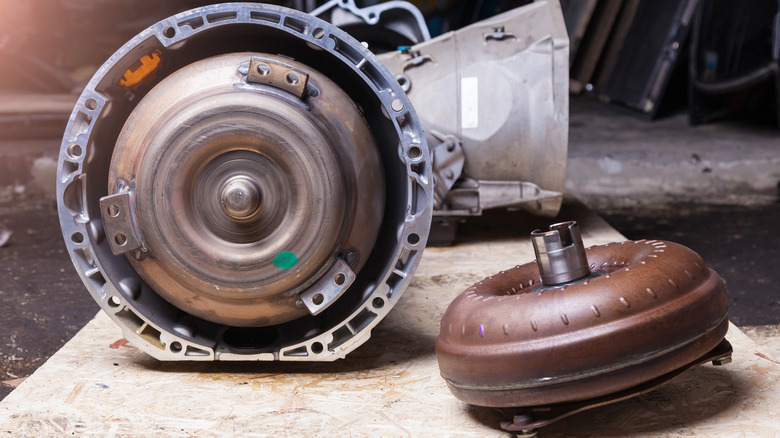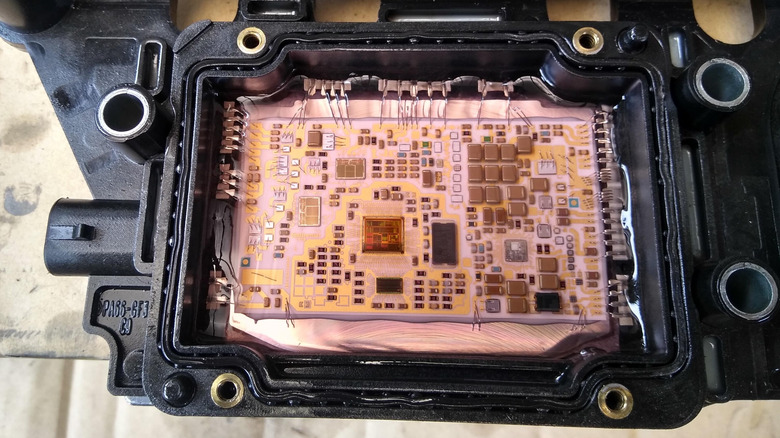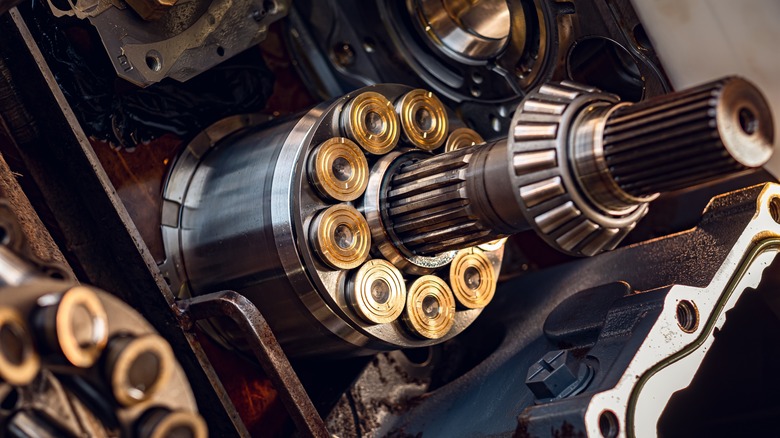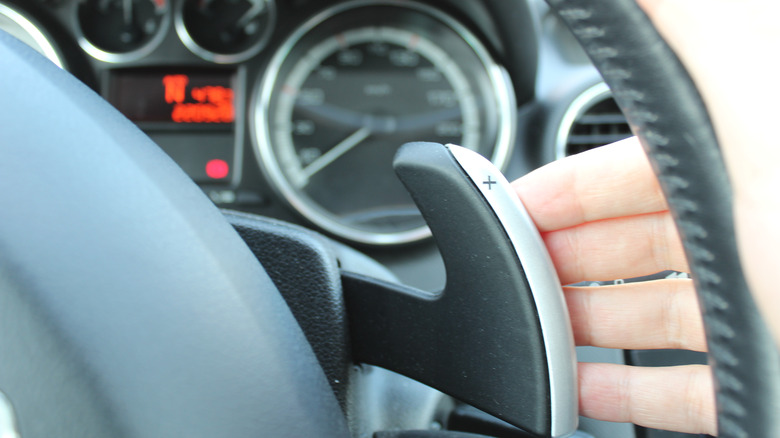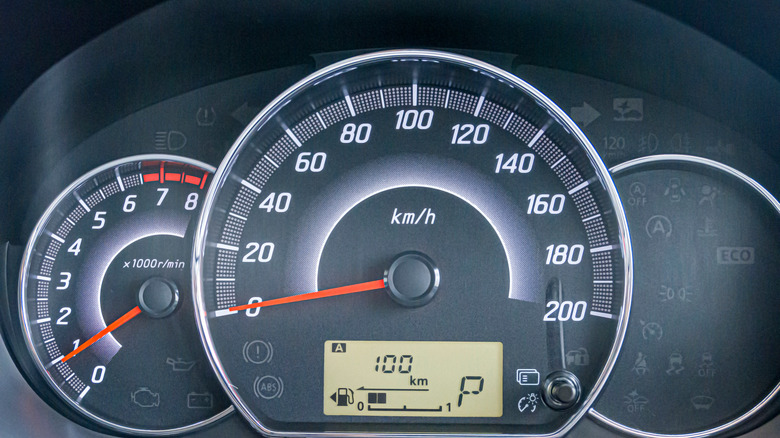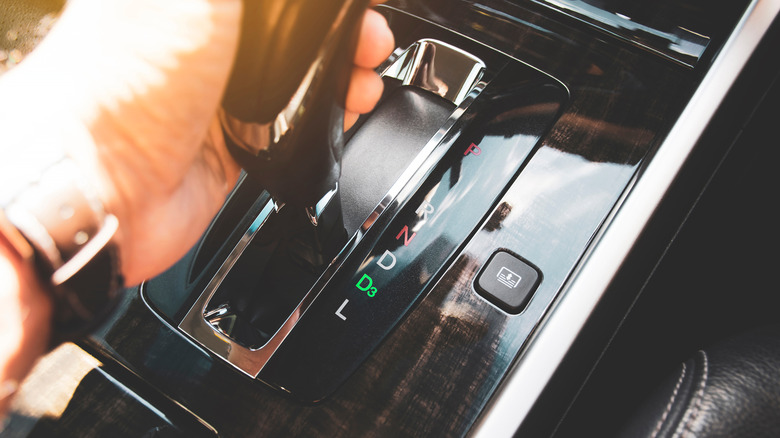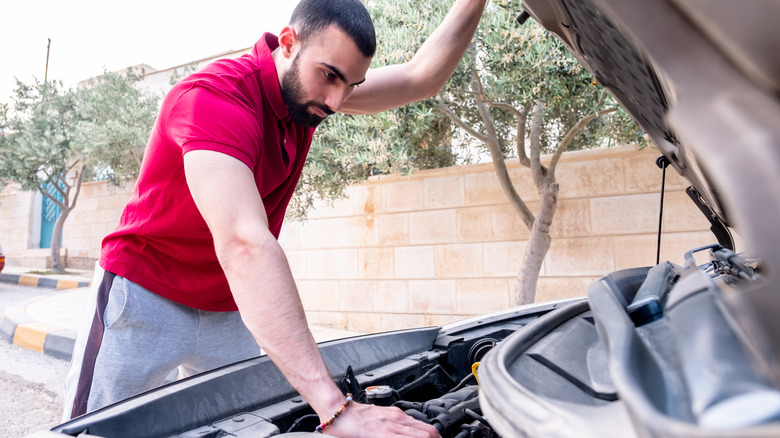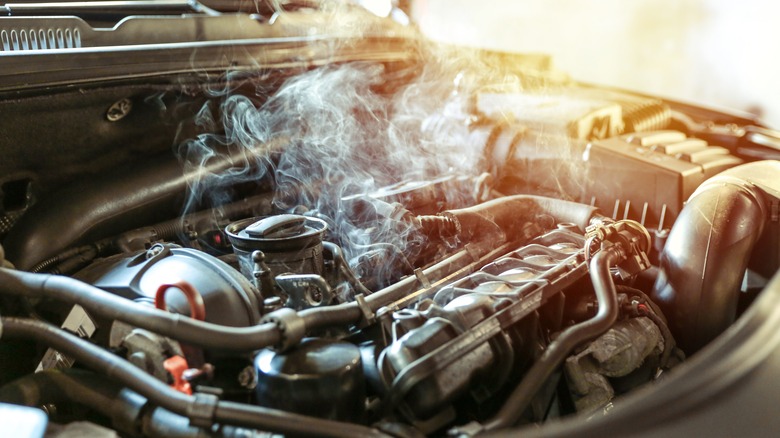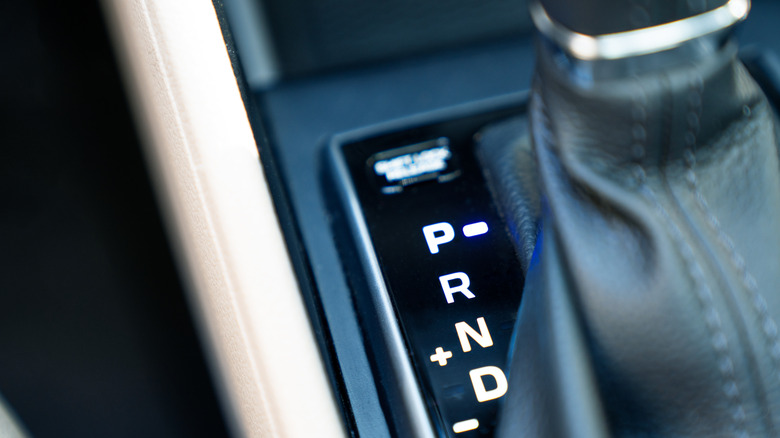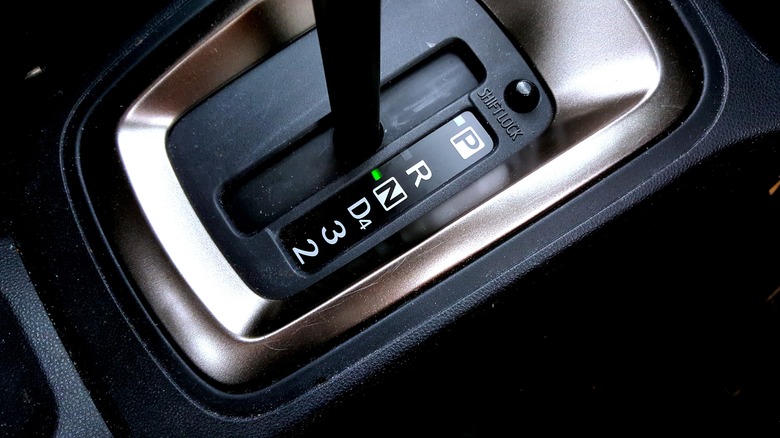11 Things You Might Not Know About The Gears In An Automatic Car
When did you last think about what goes on under the hood while cruising down the freeway in your trusty automatic ride? As you relax and enjoy the open road, the intricate dance of gears is probably the furthest thing from your mind. After all, that's the beauty of an auto transmission — it does all the hard work so you can sit back and drive.
The hydraulic automatic transmission — which uses hydraulics and multiple gears to shift smoothly — has been a mainstay for decades. However, newer options have emerged, such as the continuous variable transmission (CVT), which uses a pulley system for an infinite range of gear ratios to achieve better mileage and a smooth ride. Dual-clutch transmissions (DCT) and automated manual transmissions (AMT), meanwhile, combine the best of manuals and automatics for lightning-quick shifts with a sporty feel. Hybrids have also brought specialized electronically continuously variable transmissions (E-CVT), which are designed to maximize efficiency for electric motors.
Transmission technology has come a long way from the old days of clunky manual shifts. So what are these things made of anyway, how do they manage to work together without tripping over each other, and what can cause problems down the road? Let's take a closer look at some of the most important things there are to know about your automatic transmission.
The planetary gear set is the core of an automatic transmission
The planetary gear set, also known as an epicyclic gear set, is the brain of automatic transmissions, allowing the system to smoothly upshift and downshift while you're driving. At the core are three main parts– the sun gear in the middle, several planet gears that orbit it, and the outer ring gear, also known as the annulus.
The sun gear, located at the center, is usually hooked up to the engine's output shaft and spins around its axis. Surrounding it are the planet gears, which loop around the sun gear while spinning on their own axes. These planet gears are mounted on a carrier, which is typically all connected to the transmission's output shaft. The ring gear, which is the largest gear with inward-facing teeth, meshes with the planets and sends power to the wheels.
Automatic transmissions can get a wide range of gear ratios and speeds by selectively engaging different combinations of the sun gear, planet gears, and ring gear. This is done through a series of clutches and brakes that control which parts of the gear set are free to rotate or are held stationary. How these gears are arranged and controlled determines whether the output turns in the same direction as the input (for forward gears), goes in reverse, or spins at a different speed for various gear ratios. This allows the vehicle to have multiple speed settings, or gears, that can be utilized based on the driving conditions.
Automatic transmissions use a torque converter, not a clutch
A torque converter has three main parts that make it work: the impeller, which is attached to the engine, the turbine, which is connected to the transmission, and the stationary stator in the middle.
When the engine runs, the impeller spins and pushes transmission fluid between the parts. That fluid movement makes the turbine spin, too, transferring the power to the transmission. The stator helps redirect the fluid flow coming back from the turbine to the impeller. This makes the power transfer more efficient, resulting in better acceleration. It recycles the fluid to squeeze more torque out of each spin rather than just letting it splash around. In the end, it all works together to get the engine power into the transmission smoothly.
Another cool thing the torque converter does is multiply the engine's power when you first hit the gas when you start from a stop. This gives your vehicle a boost to get moving quicker. Moreover, many torque converters these days also have a lock-up mechanism (clutches) that rigidly connects the engine and transmission at highway speeds to improve fuel efficiency and performance.
While torque converters let automobiles shift gears smoothly and without any jerks, they do have some drawbacks in efficiency. The impeller connected to the engine and the turbine hooked to the transmission gears aren't physically locked together — they use fluid to transfer the power — so there's always a little bit of slippage happening in there. As a result, automatics use more gas than manuals since some of the engine's effort is lost in the fluid. Still, torque converters help give you smooth driving without the fuss of a clutch pedal.
The transmission control module controls gear shifting
The Transmission Control Module, or TCM for short, also known as a Gearbox Control Unit (GCU), is like the traffic cop of your vehicle's transmission. It constantly monitors how the engine and wheels interact and decides when to change gears to keep things flowing smoothly. Making these decisions in real-time would be tough for just one component, so the TCM uses feedback from sensors all over the vehicle along with some fancy algorithms to help it out.
One of the main things it watches is your speed, coupled with how fast the engine spins. If you put your foot down to pass that slow poke in the left lane, the TCM knows it needs to grab a taller gear so the engine can really wind out and push you forward. On the other hand, if you mash the brakes at a stop sign, it'll slide into a lower gear to slow both your wheels and the engine in tandem. That way, everything decelerates in sync for a smooth stop.
Today's modules can constantly adjust to how different drivers handle their wheels using adaptive learning transmission. This allows the TCM to customize its shifting patterns to match your style, whether you have a lead foot or are more of a Sunday driver.
Automatic transmissions rely on a hydraulic system
You know that slick, liquidy feel when you shift an automatic transmission from Park to Drive? That's the hydraulic system hard at work behind the scenes. This powerful fluid network is the beating heart that makes your transmission work smoothly.
The transmission relies on a pump to draw automatic transmission fluid (ATF) from the pan and generate hydraulic pressure. This pressurized fluid performs crucial functions. It applies the clutches to engage different gear ratios through careful hydraulic pressure application. It also provides pressure to keep the bands — which hold gears and components securely during operation — tightened.
Moreover, the hydraulic system lubricates and cools the transmission's moving parts by circulating the ATF throughout internal components. Hydraulic pressure is controlled by a complex valve body containing channels, ports, and solenoids routing pressurized ATF as needed depending on vehicle speed, throttle position, and gear selector position.
The hydraulic system in an automatic transmission also relies on accumulators to store backup hydraulic muscle to keep things running smoothly. They are designed to prevent sudden changes in hydraulic pressure, which can lead to harsh gear shifts. By storing and releasing pressure, they ensure a smoother transition between gears.
Some automatic cars have a manual shifting mode
While automatics are primarily designed for ease of use in everyday driving, many also offer drivers a more hands-on experience through their manual (or Sport) modes. Also called manumatic, this feature gives you some control over gear selection in a manner that is similar to driving a stick shift. To engage in manual mode, simply shift to S on the gear selector lever. From there, you can select gears by nudging the lever towards the plus or minus signs, much like operating a joystick. Some fancier rides, like the 2023 Lotus Emira, even have steering wheel paddles for gear changes right at your fingertips.
It's much simpler than rowing your own in a true manual, as no clutch work is required. However, it does allow you to hold gears longer if you want, like when passing on the highway. Just be aware that the transmission may still shift automatically to keep the engine in its power band. For instance, if you slow down too much in too high a gear, it will politely drop for you. Some vehicles, like the 2015 F-150 truck, have an additional Sport mode feature — Haul/Tow mode — typically used when towing heavy loads. This mode adjusts the transmission shift patterns and provides additional engine braking, which helps maintain control of the vehicle and the towed load.
While shifting yourself in automatic vehicles makes for a more engaging experience overall, you may see slightly worse fuel economy driving in sports mode versus normal drive mode in automatic transmissions. Constantly flipping through gears yourself also might come with additional long-term wear and tear on transmission components.
Your automatic car creeps when it is idling
Have you noticed that when you take your foot off the brake in Drive or Reverse that it just starts creeping forward or backward even though you're not on the gas pedal? That's called idle creep.
Idle creep has a couple of handy benefits. First, it makes taking off from a stop super smooth, which means that you don't have to constantly feather the gas pedal in bumper-to-bumper traffic or tight spaces. Second, it helps you maintain control when parking or moving at low speeds. Being able to roll a bit without hitting the gas prevents you from stalling out and lets you guide the vehicle where you need it to go with more gentle control. It's pretty useful for parking lot maneuvering or squeezing down tight city streets.
The speed at which your automobile creeps forward at idle can vary a bit depending on factors like make, model, and transmission. Usually, it's around the speed of a brisk walk, although some cars really noticeably creep along, while others are pretty subtle. Either way, the basic idea is the same — it lets you roll a bit without always having your foot on a pedal in traffic or waiting in a line.
Overdrive reduces engine RPMs at high speeds
Overdrive in an automatic transmission lets you cruise at higher speeds without working the engine too hard or using too much gas. It basically tweaks the gearing on the highest gear, so it acts like an extra speed, letting the RPM stay lower even when you're going faster.
This helps save on both engine wear over longer distances and what you pay at the pump. For example, at 70 mph, most transmissions need the engine's RPMs around 3,000 just to power the wheels at that speed. Overdrive modifies this by providing an additional top gear, letting the engine unwind to perhaps 2,000 to 3,000 RPM at 70 mph. This reduces mechanical stress and wear over long periods, and you may notice a boost in fuel economy on extended highway journeys.
Modern automatic vehicles activate overdrive automatically once they reach highway speeds, seamlessly shifting into that extra efficient gear ratio. In older vehicles, drivers can manually turn overdrive on or off using a button on the gear selector. You may feel a subtle shift as the transmission smoothly engages overdrive. However, it's best to avoid using overdrive when climbing steep grades, towing heavy loads, or trying to overtake other drivers — let the transmission downshift conventionally in those scenarios.
Unusual noises from the gearbox may indicate a malfunction
If you've heard some weird sounds from under the hood lately, don't ignore them! Your car is trying to tell you that the gearbox may not be quite right. Different types of unusual noises can provide clues about what might be going on in there.
A whining or whirring noise during acceleration is never a good sign, and it could indicate that there's excess friction between gears that shouldn't be making direct contact. This frequently happens when there is a low hydraulic fluid level or obstructions in the fluid lines, which restrict the flow of hydraulic fluid, preventing it from reaching all the necessary areas and properly lubricating the gears. It could also point to a worn-out pump struggling to circulate everything properly.
Sounds such as clunking, grinding, or gurgling can also indicate that your gearbox might be low on transmission fluid. You shouldn't overlook less noticeable signs like rumbling, jerking, hesitation, or trembling during gear changes. These could be early warning signs of potential issues with your automatic transmission. The transmission is too complicated to ignore strange noises. Leaving them unchecked risks costly damage developing over time. As soon as you notice unfamiliar transmission noises, it's important to have a mechanic take a look. It is better to catch small issues before they escalate into something requiring major repairs down the road.
Overheating is bad for an automatic transmission
If a transmission gets too hot, it's being pushed past what it was designed for. There are a few obvious signs that your car's transmission may be overheating, and you don't want to ignore them if you want to avoid some serious damage down the road.
One big tip-off is smelling a distinct burnt odor coming from under the hood. You might also notice issues with how the gears are shifting, like delays changing gears, feeling really jerky when it switches, or hearing some weird noises from the transmission. Also, look out for leaks. The transmission fluid is probably leaking out if you see reddish-brown fluid dripping from your car.
A few different things can cause your transmission to get too hot. Driving when it's super hot outside or pulling a heavy vehicle can stress the transmission and could make it overheat. Other potential culprits are being low on ATF, a transmission coolant that's stopped working right, or an engine running too hot.
If your vehicle's transmission starts to overheat, it's one of the clear signs that your automatic transmission requires professional attention and repair. Even just one overheating episode can cause some serious long-term damage down the line. So, keep an eye on your fluid levels and transmission cooler so you catch any potential issues before they get out of hand — regular maintenance is the way to go.
You shouldn't put your car in park before stopping completely
When it comes to operating an automatic car, several nuances can make a big difference in the longevity and performance of your vehicle. One such detail is the proper use of the parking gear. Many drivers may not realize the potential harm they are causing by engaging the parking gear before the car has come to a complete stop.
The parking gear in an automatic transmission is designed to lock the transmission, preventing the car from rolling when parked. This gear engages a mechanism known as the parking pawl, a small metal pin that locks the transmission's output shaft. You risk damaging this pawl and other transmission components when you shift into park while the car is still in motion, even at a low speed, as the sudden engagement can cause undue stress and lead to expensive repairs.
To avoid these issues, always ensure your vehicle is completely at a standstill before shifting into the park gear. Use the brake pedal to bring the car to a stop, hold it there until you've shifted into Park, and then engage the parking brake for added security. This sequence of actions will protect your transmission from unnecessary wear and tear and keep you and your vehicle safe.
You shouldn't use your neutral gear while driving
Unlike what some may think, neutral isn't actually a gear — it's when no gear is engaged at all. In this state, the wheels can spin independently without any power being sent from the gas pedal. One misconception is that shifting a vehicle into neutral while moving, especially when going downhill, can lead to significant gas savings. However, most automatic transmissions use about the same amount of fuel, whether in gear or neutral. In fact, being in neutral may be worse for mileage since the engine has to work harder to keep pace without gearing.
The real risk when rolling in neutral is losing control of your vehicle. With the engine disengaged from the transmission, no power goes to the wheels for accelerating or braking. That can cause problems, especially downhill — without engine braking assisting, it's easier to start picking up speed involuntarily. You're then relying solely on the regular brakes, risking overheating them if you have to slow down sharply. Emergency situations become dicier, too, since you won't have instant access to acceleration if you need to speed up suddenly.
There are a few instances when going neutral while driving an automatic vehicle is okay. For instance, if your transmission breaks, your vehicle is stuck, or the gas and brake pedals are not working, neutral lets the wheels turn freely to get it towed or fixed. But even then, be very careful and only use it when there's no other choice.
